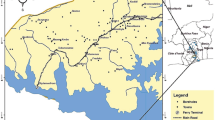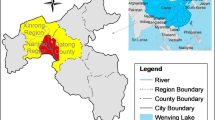Abstract
Assessment of the vulnerability of karst groundwater to pollution can help in managing and protecting groundwater resources. Most karst areas with important groundwater reservoirs in southwest China are not protected by regulations governing environmental pollution, so the groundwater is easily polluted. In this paper, a case study of the vulnerability of groundwater to pollution is presented from the karstic, subtropical Jiangjia spring area (Chongqing, China). The methodology in this paper is based on the pan-European approach to assessing the vulnerability of groundwater to pollution, and is complemented by newly acquired fieldwork data. Two earlier approaches developed for case studies in Slovenia and Vietnam are tested in the present study area, and improvements to the approached are proposed. Both approaches yield reasonable results, with some notable differences. A degree of extreme vulnerability is assigned by both methods to an area with a sinking river, and also to local depressions where an estavelle is present. The main difference in the results of the two methods is the vulnerability of most karst areas. The Slovenian approach classified most of the karst areas as highly vulnerable, whereas the Vietnamese approach assigned a medium degree of vulnerability. The Slovenian approach requires more information and data, when compared with the Vietnamese approach. The results of vulnerability assessment were independently verified by spatial variation diagrams for nitrate.







Similar content being viewed by others
References
Aller L, Bennet T, Lehr JH and Petty RJ (1987) DRASTIC: A standardised system for evaluating groundwater pollution potential using hydrologic settings. US EPA Report, 600/2-87/035, Robert S. Kerr Environmental Research Laboratory, Ada, OK
Andreo B, Goldscheider N, Vadillo I, Vías JM, Neukum C, Sinreich M, Jiménez P, Brechenmacher J, Carrasco F, Hötzl H, Perles MJ, François Z (2006) Karst groundwater protection: first application of a Pan-European approach to vulnerability, hazard and risk mapping in the Sierra
Bakalowicz M (2005) Karst groundwater: a challenge for new resource. Hydrogeol,13(1): 148–160
Daly D, Dassargues A, Drew D, Dunne S, Goldscheider N, Neale S, Popescu IC, Zwahlen F (2002) Main concepts of the European Approach for (karst) groundwater vulnerability assessment and mapping. Hydrogeol J 10(2):340–345
DoELG/EPA/GSI (1999) Groundwater protection schemes. Department of Environment and Local Government, Environmental Protection Agency and Geological Survey of Ireland, Dublin, p 24
Doerfliger N, Jeannin PY, Zwahlen F (1999) Water vulnerability assessment in karst environments: a new method of defining protection areas using a multi-attribute approach and GIS tools (EPIK method). Environ Geol 39(2):165–176
François Z (ed) (2004) Vulnerability and risk mapping for the protection of carbonate (karst) aquifers, final report (COST action 620). European Commission, Directorate-General for research, EUR 20912:297 GB/T 14848-93 (1994) The groundwater quality standard, State Bureau of Technical Supervision, The People’s Republic of China
Gogu RC, Hallet V, Dassargues A (2003) Comparison of aquifer vulnerability assessment techniques: application to the Neblon River basin (Belgium). Environ Geol 44(8):881–892
Goldscheider N (2003) Karst groundwater vulnerability mapping: application of a new method in the Swabian Alb. Germany. Hydrogeol J 13:555–564
Goldscheider N, Klute M, Sturm S, Hötzl H (2000) The PI method—a GIS-based approach to mapping groundwater vulnerability with special consideration of karst aquifers. Z Angew Geol 46(3):157–166
Katschinski NA(1956). Die mechanische Bodenanalyse und die Klassifikation der Bo¨den nach ihrer mechanischen Zusammensetzung. Rapports au Sixie´me Congre´s de la Science du Sol Paris, B, pp 321–327
Neukum C, Hötzl H, Himmelsbach T (2008) Validation of vulnerability mapping methods by field investigations and numerical modelling. Hydrogeol J 16(4):641–658
Nguyet VTM, Goldscheider N (2006) A simplified methodology for mapping groundwater vulnerability and contamination risk, and its first application in a tropical karst area. Vietnam. Hydrogeol J 14:1666–1675
Ravbar N (2007) Vulnerability and risk mapping for the protection of karst waters in Slovenia: application to the catchment of the Podstenjšek springs (in English). PhD Thesis, University of Nova Gorica, Slovenia
Ravbar N, Goldscheider N (2007) Proposed methodology of vulnerability and contamination risk mapping for the protection of karst aquifers in Slovenia. Acta Carsol 36(3):461–475
Ravbar N, Goldscheider N (2009) Comparative application of four methods of groundwater vulnerability mapping in a Slovene karst catchment. Hydrogeol J 17:725–733
Vías JM, Andreo B, Perles MJ, Carrasco F, Vadillo I, Jiménez P (2002) Preliminary proposal of a method for vulnerability mapping in carbonate aquifers. In: Carrasco F, Durán JJ, Andreo B (eds) Karst and environment, pp 75–83
Vrba J, Zaporozec A (1994) Guidebook on mapping groundwater vulnerability. Int Assoc Hydrogeo Verl Heinz Heise 16:131
Yao CH (2002) The sensitivity dynamic evaluation of karst hydrological system in Shuicheng Basin, Guizhou Province. China University of Geoscience, Wuhan
Yuan DX, Xue YQ, Fu JM, Zhen D, Wang JY, Lin XY, Chen MX (2007) Countermeasures and suggestions to prevent karst underground river Southwest China turn into sewers. Chinese Acad Sci Suggest 164
Zhang C (2003) The groundwater vulnerability assessment and the relationship to the landuse spatial change in Houzai underground river basin, Puding County. Guizhou province. Guilin, Chinese Academy of Geological Sciences
Zhang C, Lettingue Michèle, Jiang YJ, Wang S (2007) Duality method for assessing karst groundwater vulnerability and its application in Jinfo mountain of Chongqing. Carsologica Sinca 26(4):334–340
Zhang Q, Lin YS (2011) Intrinsic vulnerability assessment of karst groundwater aquifer in the Qingmuguan Basin. Earth Environ 39(4):523–530
Zhang Q, Jiang YJ, Lin YS, Liu LH, Hu N (2009) Karst groundwater vulnerability and contamination risk assessment based on the European model. Yangtze River 40(13):51–54
Zhou SZ, Zhang WH, Liang B (2005) A discussion of the assessment of groundwater vulnerability in epikarst zone of the karst area Southwest China. Earth Sci Front 12(Suppl):152–158
Acknowledgments
This work was supported by the National Science Foundation of China (41202184) and a China Geological Survey Project (12120113006700). Special thanks to Academician Yuan and my classmate (Southwest University) for field work and indoor laboratory.
Author information
Authors and Affiliations
Corresponding author
Rights and permissions
About this article
Cite this article
Zhang, Q. An assessment of groundwater resource vulnerability to pollution in the Jiangjia spring basin, China. Environ Earth Sci 74, 985–995 (2015). https://doi.org/10.1007/s12665-014-3732-5
Received:
Accepted:
Published:
Issue Date:
DOI: https://doi.org/10.1007/s12665-014-3732-5




